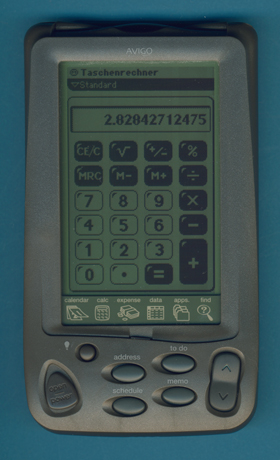
DATAMATH CALCULATOR MUSEUM
 |
DATAMATH CALCULATOR MUSEUM |
Texas Instruments Avigo 10
| Date of introduction: | September 16, 1997 | Display technology: | LCD dot matrix |
| New price: | $299 | Display size: | 240 * 160 pixels |
| Size: | 5.5" x 3.3" x 0.7" | ||
| Weight: | 6.5 ounces | Serial No: | |
| Batteries: | 2*AAA + CR2025 | Date of manufacture: | mth 09 year 1997 |
| AC-Adapter: | Origin of manufacture: | Taiwan (I) | |
| Precision: | 17 | Integrated circuits: | CPU: Inventec 6SI117 Flash: AMD 29F080 RAM: EPSON SRM20100 Display: Toshiba 6C23, Toshiba 6C24 |
| Memories: | 1024kB Flash-ROM 128kB RAM | ||
| Program steps: | Courtesy of: | Joerg Woerner |

![]()
 The
Avigo 10 PDA (Personal Digital Assistant) introduced already in September 1997
uses a completely different approach compared to Texas Instruments' Personal Organizers,
e.g. the
PocketMate 300. Instead of a spacy keyboard the smaller Avigo 10 uses a
bold,
touch-sensitive display with a resolution of 160*240 dots. A nice feature,
especially for tables, is the ability to rotate the data, viewing it "landscape"
rather than "portrait".
The
Avigo 10 PDA (Personal Digital Assistant) introduced already in September 1997
uses a completely different approach compared to Texas Instruments' Personal Organizers,
e.g. the
PocketMate 300. Instead of a spacy keyboard the smaller Avigo 10 uses a
bold,
touch-sensitive display with a resolution of 160*240 dots. A nice feature,
especially for tables, is the ability to rotate the data, viewing it "landscape"
rather than "portrait".
|
Next to the display are several
buttons including a rocker switch that scrolls windows and messages, a
power switch and a button to illuminate the backlight. The Avigo offers
the usual array of PDA functions and has the capacity to upload
applications. Using its stylus, users can navigate through four main
applications: • Memo Another set of buttons along the
bottom of the screen offers access to the: • Calendar A third set of programms is
accessible from the general applications button: • Memory |


![]() Users
of the Avigo 10 have two choices to enter their data with the stylus into the
different applications:
Users
of the Avigo 10 have two choices to enter their data with the stylus into the
different applications:
• A
standard graphics keyboard.
with the typical three characters per
key.
 The
Avigo 10 is bundled with a customized version of the Lotus® Organizer™ 97,
the leading personal information management software. It takes control of the
calendar, address book, task list, and more. Also included is the IntelliSync™
software to synchronize the appointments, tasks, contacts, and more, directly
with Lotus Organizer 97 on the desktop PC.
The
Avigo 10 is bundled with a customized version of the Lotus® Organizer™ 97,
the leading personal information management software. It takes control of the
calendar, address book, task list, and more. Also included is the IntelliSync™
software to synchronize the appointments, tasks, contacts, and more, directly
with Lotus Organizer 97 on the desktop PC.


 Dismantling
this Avigo 10 PDA manufactured in September 1997 by Inventec
Corporation in Taiwan reveals a very complex, yet high integrated
system based on an Application Specific Integrated Circuit (ASIC). The main
electronics is compromised of two printed circuit boards (PCB's), the larger PCB
hosts the ASIC and memory chips, while the smaller PCB supports the huge,
touch-sensitive display.
Dismantling
this Avigo 10 PDA manufactured in September 1997 by Inventec
Corporation in Taiwan reveals a very complex, yet high integrated
system based on an Application Specific Integrated Circuit (ASIC). The main
electronics is compromised of two printed circuit boards (PCB's), the larger PCB
hosts the ASIC and memory chips, while the smaller PCB supports the huge,
touch-sensitive display.
 The Avigo handheld PDA is based on
a modified Z80 microprocessor, which has a 16-bit memory address bus. That means
it can directly access up to 64k bytes. The Avigo Operating System is able to
access multiple megabytes of memory using a technique known as "banking"
or "paging", selecting 16k banks of extended memory to appear in 2
memory regions as needed. Like most other computers, Avigo memory is designated
as RAM and ROM. The ROM however, is EEPROM (electrically erasable ROM), and the
operating system and applications can - and do -routinely alter its contents.
The Avigo handheld PDA is based on
a modified Z80 microprocessor, which has a 16-bit memory address bus. That means
it can directly access up to 64k bytes. The Avigo Operating System is able to
access multiple megabytes of memory using a technique known as "banking"
or "paging", selecting 16k banks of extended memory to appear in 2
memory regions as needed. Like most other computers, Avigo memory is designated
as RAM and ROM. The ROM however, is EEPROM (electrically erasable ROM), and the
operating system and applications can - and do -routinely alter its contents.
 The
64k of base memory contains four 16k regions as follows:
The
64k of base memory contains four 16k regions as follows:
• $0000 - $3FFF System ROM region
•
•
•
The
1MByte Flash memory of the Avigo 10 with approx. 680KB available for the user
could be expanded with a small 1MByte module.
![]() The
smaller of the two PCB's supports the touch-sensitive display and uses with the
Toshiba 6C23 and 6C24
very high integrated column resp. row drivers.
The
smaller of the two PCB's supports the touch-sensitive display and uses with the
Toshiba 6C23 and 6C24
very high integrated column resp. row drivers.
![]()
The Avigo 10 had never the appeal of the Apple Newton or the
success of the 3Com’s Palm Pilot series. With the introduction of the first
Windows CE based PDA’s Texas Instruments discontinued the Avigo.
Don't miss the Personal Learning Tool PLT SHH1 based on a very similiar technology!
If you have additions to the above article please email: joerg@datamath.org.
© Joerg Woerner, January 17, 2002. No reprints without written permission.